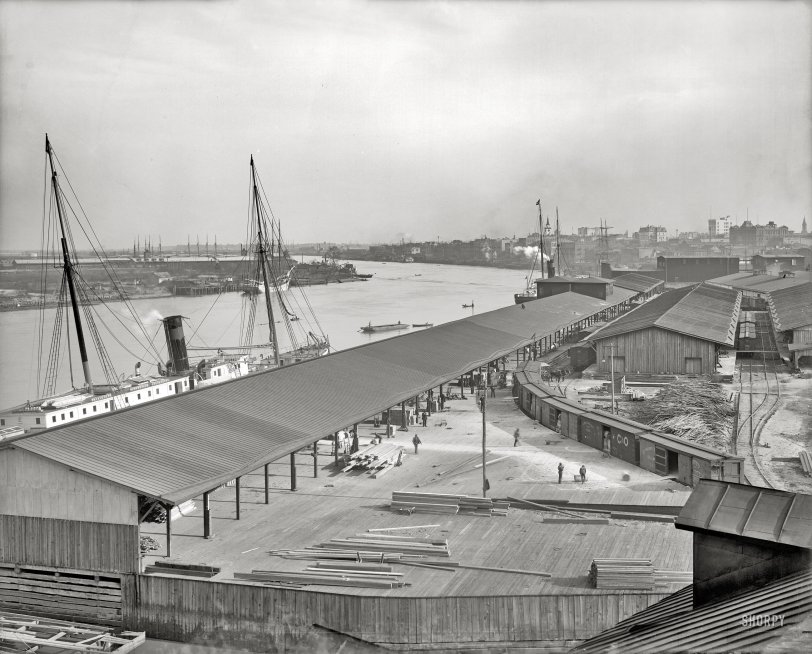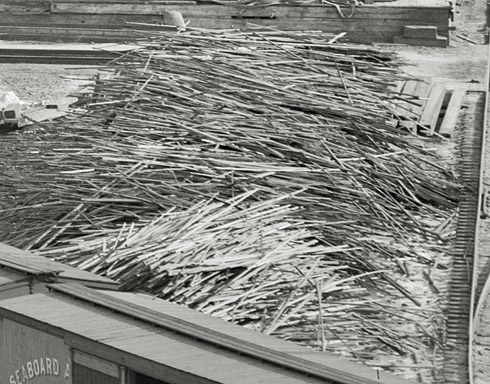


Framed or unframed, desk size to sofa size, printed by us in Arizona and Alabama since 2007. Explore now.
Shorpy is funded by you. Patreon contributors get an ad-free experience.
Learn more.

- Baldwin 62303
- Baldwin VO-1000
- Cold
- No expense spared
- Tough Guys
- Lost in Toyland
- And without gloves
- If I were a blindfolded time traveler
- Smoke Consumer Also Cooks
- Oh that stove!
- Possibly still there?
- What?!?
- $100 Reward
- Freeze Frame
- Texas Flyer wanted
- Just a Year Too Soon
- WWII -- Replacing men with women at the railroad crossing.
- Yes, Icing
- You kids drive me nuts!
- NOT An Easy Job
- I wonder
- Just add window boxes
- Icing Platform?
- Indiana Harbor Belt abides
- Freezing haze
- Corrections (for those who care)
- C&NW at Nelson
- Fallen Flags
- A dangerous job made worse
- Water Stop
Print Emporium
Down the River: 1906

The Savannah River circa 1906. "Down the river -- Savannah, Georgia." 8x10 inch dry plate glass negative, Detroit Publishing Company. View full size.
Tide's out
All three ships on this side of the river are listing to port, must be sitting on the bottom.
Dixie Crystals
Savannah was a major importation point for Caribbean sugar (and, later, for exporting it, after the sugar refinery was built in 1917). So I'm guessing that's what the white stuff is. The port also exported millions of barrels of gum resin ("pine rosin") every year, but that was more of an amber or brown color.
Lumber
Oh, I used to work at lumber plant, so it's very familiar picture to me. The roof warehouse is incredibly straight, even as а tight string.
Sawyer's work area.
I am pretty sure what we are looking at is new construction and the sawyer for the site left the big pile of waste. There is fresh lumber still stacked here and there and that area next to the big pile looks like where a mill had been to dimension the wood for all the decking/buildings as needed. They probably had to rip all the decking to width from rough cut wood. So these are just the off cuts waiting to be used or hauled away. I have been that guy on a few jobs and the pile looks familiar -- much bigger, but familiar.
Ghost Ship
The ship across the way resembles one from a century earlier.
Flour
leaking out of the barrels, I would think.
Kindling
That may indeed be kindling. I lived near the GM&O RR shops in the 1930s and there was always a huge pile of pine strips that was used for starting the fires in locomotives. My friends and I made many a "sword" out of selected strips and baling wire. A few whacked knuckles resulted from our "sword fights", but I don't remember there being any serious hurts.
Strips like those were also used on interior walls of houses which were intended to be plastered, but I imagine those strips were used in the boilers of the steam boats of which two big ones are visible. Barrel staves would be wider I think , but then what do I know!
Land Bridges.
Note the pedestrian crossover bridges over the double railroad tracks between the two platforms on the right, supported by a portable sawhorse-like piers.
Fifty-odd years later railroad flat cars with their trucks turned 90 degrees were used as rolling bridges to accomplish the same purpose to allow fork lifts to cross the gap, the car trucks riding on the same rails used by the freight cars.
Thank You, Sir!
A lot to look at
A barge being pulled by a rowboat. I think I'd want the steering job. I wonder what the white powder is that's coming out of the barrels they're loading.
1906 water dispersal
I like the way the builders managed the rainwater hitting the roof to direct it to the guttering that takes the runoff directly under the floor of the open building to the river. Another great pic of early 20th century ingenuity.
Barrels-to-be
Most of the cargo here is being shipped in barrels. Check out the enormous pile of kindling next to the tracks. Looks like wood strips that can be cut to length for use as barrel staves.

























On Shorpy:
Today’s Top 5